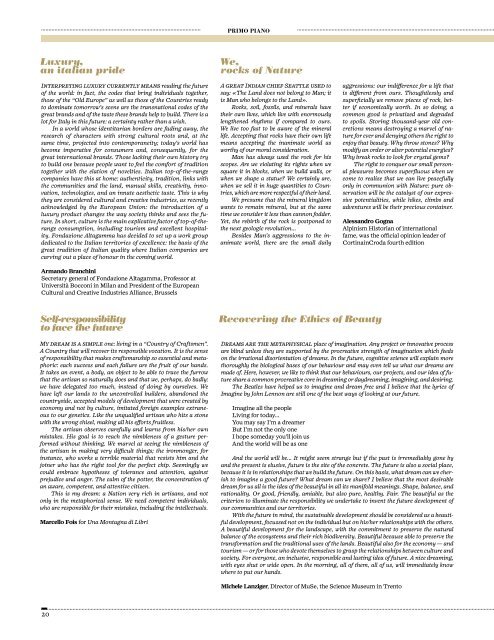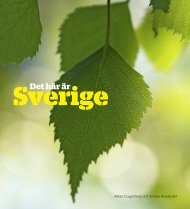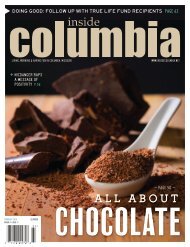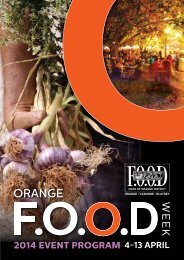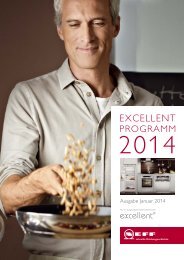Cortina Inverno
Eccoci arrivati al decimo numero di CORTINA.TOPic. Una bella strada, quella che abbiamo percorso assieme. Con un obiettivo interessante, quello di dar vita — cinque stagioni or sono — a una rivista dalla doppia vocazione: di approfondimento e promozione, capace di immortalare la Cortina che ci piace e di dar voce a chi la ama, guardando sempre al futuro, forti di un illustre passato.
Eccoci arrivati al decimo numero di CORTINA.TOPic.
Una bella strada, quella che abbiamo percorso assieme. Con
un obiettivo interessante, quello di dar vita — cinque stagioni
or sono — a una rivista dalla doppia vocazione: di approfondimento
e promozione, capace di immortalare la Cortina che
ci piace e di dar voce a chi la ama, guardando sempre al futuro, forti di un
illustre passato.
You also want an ePaper? Increase the reach of your titles
YUMPU automatically turns print PDFs into web optimized ePapers that Google loves.
Luxury,<br />
an italian pride<br />
Interpreting luxury currently means reading the future<br />
of the world: in fact, the codes that bring individuals together,<br />
those of the “Old Europe” as well as those of the Countries ready<br />
to dominate tomorrow’s scene are the transnational codes of the<br />
great brands and of the taste these brands help to build. There is a<br />
lot for Italy in this future: a certainty rather than a wish.<br />
In a world whose identitarian borders are fading away, the<br />
research of characters with strong cultural roots and, at the<br />
same time, projected into contemporaneity; today’s world has<br />
become imperative for consumers and, consequently, for the<br />
great international brands. Those lacking their own history try<br />
to build one because people want to feel the comfort of tradition<br />
together with the elation of novelties. Italian top-of-the-range<br />
companies have this at home: authenticity, tradition, links with<br />
the communities and the land, manual skills, creativity, innovation,<br />
technologies, and an innate aesthetic taste. This is why<br />
they are considered cultural and creative industries, as recently<br />
acknowledged by the European Union: the introduction of a<br />
luxury product changes the way society thinks and sees the future.<br />
In short, culture is the main explicative factor of top-of-therange<br />
consumption, including tourism and excellent hospitality.<br />
Fondazione Altagamma has decided to set up a work group<br />
dedicated to the Italian territories of excellence: the basis of the<br />
great tradition of Italian quality where Italian companies are<br />
carving out a place of honour in the coming world.<br />
Armando Branchini<br />
Secretary general of Fondazione Altagamma, Professor at<br />
Università Bocconi in Milan and President of the European<br />
Cultural and Creative Industries Alliance, Brussels<br />
Self-responsibility<br />
to face the future<br />
My dream is a simple one: living in a “Country of Craftsmen”.<br />
A Country that will recover its responsible vocation. It is the sense<br />
of responsibility that makes craftsmanship so essential and metaphoric:<br />
each success and each failure are the fruit of our hands.<br />
It takes an event, a body, an object to be able to trace the furrow<br />
that the artisan so naturally does and that we, perhaps, do badly:<br />
we have delegated too much, instead of doing by ourselves. We<br />
have left our lands to the uncontrolled builders, abandoned the<br />
countryside, accepted models of development that were created by<br />
economy and not by culture, imitated foreign examples extraneous<br />
to our genetics. Like the unqualified artisan who hits a stone<br />
with the wrong chisel, making all his efforts fruitless.<br />
The artisan observes carefully and learns from his/her own<br />
mistakes. His goal is to reach the nimbleness of a gesture performed<br />
without thinking. We marvel at seeing the nimbleness of<br />
the artisan in making very difficult things; the ironmonger, for<br />
instance, who works a terrible material that resists him and the<br />
joiner who has the right tool for the perfect chip. Seemingly we<br />
could embrace hypotheses of tolerance and attention, against<br />
prejudice and anger. The calm of the potter, the concentration of<br />
an aware, competent, and attentive citizen.<br />
This is my dream: a Nation very rich in artisans, and not<br />
only in the metaphorical sense. We need competent individuals,<br />
who are responsible for their mistakes, including the intellectuals.<br />
Marcello Fois for Una Montagna di Libri<br />
20<br />
priMo piano<br />
We,<br />
rocks of Nature<br />
A great Indian chief Seattle used to<br />
say: «The Land does not belong to Man; it<br />
is Man who belongs to the Land».<br />
Rocks, soil, fossils, and minerals have<br />
their own lives, which live with enormously<br />
lengthened rhythms if compared to ours.<br />
We live too fast to be aware of the mineral<br />
life. Accepting that rocks have their own life<br />
means accepting the inanimate world as<br />
worthy of our moral consideration.<br />
Man has always used the rock for his<br />
scopes. Are we violating its rights when we<br />
square it in blocks, when we build walls, or<br />
when we shape a statue? We certainly are,<br />
when we sell it in huge quantities to Countries,<br />
which are more respectful of their land.<br />
We presume that the mineral kingdom<br />
wants to remain mineral, but at the same<br />
time we consider it less than cannon fodder.<br />
Yet, the rebirth of the rock is postponed to<br />
the next geologic revolution...<br />
Besides Man’s aggressions to the inanimate<br />
world, there are the small daily<br />
Recovering the Ethics of Beauty<br />
aggressions: our indifference for a life that<br />
is different from ours. Thoughtlessly and<br />
superficially we remove pieces of rock, better<br />
if economically worth. In so doing, a<br />
common good is privatized and degraded<br />
to spoils. Storing thousand-year old concretions<br />
means destroying a marvel of nature<br />
for ever and denying others the right to<br />
enjoy that beauty. Why throw stones? Why<br />
modify an order or alter potential energies?<br />
Why break rocks to look for crystal gems?<br />
The right to conquer our small personal<br />
pleasures becomes superfluous when we<br />
come to realize that we can live peacefully<br />
only in communion with Nature: pure observation<br />
will be the catalyst of our expressive<br />
potentialities, while hikes, climbs and<br />
adventures will be their precious container.<br />
Alessandro Gogna<br />
Alpinism Historian of international<br />
fame, was the official opinion leader of<br />
<strong>Cortina</strong>inCroda fourth edition<br />
Dreams are the metaphysical place of imagination. Any project or innovative process<br />
are blind unless they are supported by the procreative strength of imagination which feeds<br />
on the irrational disorientation of dreams. In the future, cognitive science will explain more<br />
thoroughly the biological bases of our behaviour and may even tell us what our dreams are<br />
made of. Here, however, we like to think that our behaviours, our projects, and our idea of future<br />
share a common procreative core in dreaming or daydreaming, imagining, and desiring.<br />
The Beatles have helped us to imagine and dream free and I believe that the lyrics of<br />
Imagine by John Lennon are still one of the best ways of looking at our future.<br />
Imagine all the people<br />
Living for today...<br />
You may say I’m a dreamer<br />
But I’m not the only one<br />
I hope someday you’ll join us<br />
And the world will be as one<br />
And the world will be... It might seem strange but if the past is irremediably gone by<br />
and the present is elusive, future is the site of the concrete. The future is also a social place,<br />
because it is in relationships that we build the future. On this basis, what dream can we cherish<br />
to imagine a good future? What dream can we share? I believe that the most desirable<br />
dream for us all is the idea of the beautiful in all its manifold meanings. Shape, balance, and<br />
rationality. Or good, friendly, amiable, but also pure, healthy. Fair. The beautiful as the<br />
criterion to illuminate the responsibility we undertake to invent the future development of<br />
our communities and our territories.<br />
With the future in mind, the sustainable development should be considered as a beautiful<br />
development, focussed not on the individual but on his/her relationships with the others.<br />
A beautiful development for the landscape, with the commitment to preserve the natural<br />
balance of the ecosystems and their rich biodiversity. Beautiful because able to preserve the<br />
transformation and the traditional uses of the lands. Beautiful also for the economy — and<br />
tourism — or for those who devote themselves to grasp the relationships between culture and<br />
society. For everyone, an inclusive, responsible and lasting idea of future. A nice dreaming,<br />
with eyes shut or wide open. In the morning, all of them, all of us, will immediately know<br />
where to put our hands.<br />
Michele Lanziger, Director of MuSe, the Science Museum in Trento


